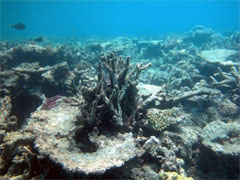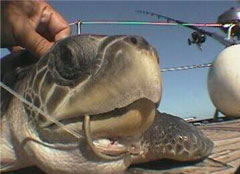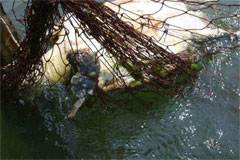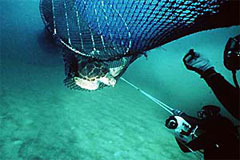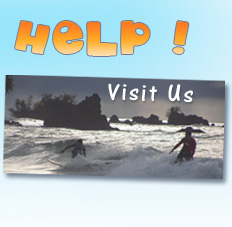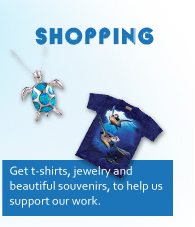Taxonomy
Kingdom: Animalia
Phylum: Chordata
Class: Reptilia
Order: Testudines
Suborder: Cryptodira
Superfamily: Chelonioidea
- Family: Cheloniidae
+Genera: Caretta
+Genera: Chelonia
+Genera: Eretmochelys
+Genera: Lepidochelys
+Genera: Natator
- Family: Dermochelyidae
+Genera: Dermochelys
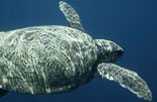 |
 |
Loggerhead turtle Caretta caretta |
Green turtle Chelonia midas |
 |
 |
Hwksbill turtle Eretmochelys imbricata |
Olive Ridley Lepidochelys olivacea |
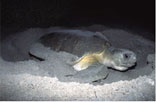 |
 |
Flatback turtle Natator depressus |
Leatherback turtle Dermochelys coriacea |
Ecology
Description
Sea turtles are reptiles that live in a marine or brackish environment. The flippers of sea turtles are long and paddle-like, making them excellent for swimming but poor for walking on land. Another characteristic that helps sea turtles swim easily is their streamlined carapace, or shell.
Reproduction
Sea turtles start their lives in eggs buried in the sand. After a two-month incubation, the young turtles hatch and run to the sea, facing attack by a variety of predators (e.g., birds, crabs, fish) along the way. They drift at sea until they are about a foot long and then, depending on the species, may move closer to shore to feed.
Sea turtles mature at around age 30. The males then spend their whole lives at sea, while females mate with the males at sea and then go to the beach to dig a hole and lay their eggs. Female sea turtles may lay eggs several times during a single season.
Migration
Sea turtle migrations are extreme - with turtles sometimes traveling thousands of miles between cooler feeding grounds and warm nesting grounds. A leatherback turtle was reported in January 2008 to have undertaken the longest known vertebrate migration - over 12,000 miles (this was later surpassed by the Arctic tern, who was found to make a record 50,000-mile migration. The turtle was tracked by satellite for 674 days from its nesting area in Jamursba-Medi beach in Papua, Indonesia to feeding grounds off Oregon.
As more sea turtles are tracked using satellite tags, we learn more about their migrations and the implications their travels have for their protection - laws protecting sea turtles in one area may be inadequate if those rules don't apply where the turtles migrate.

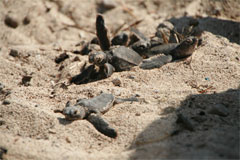

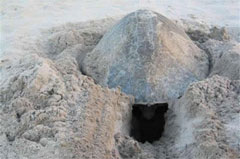
Turtles and Man
These ancient creatures have been on Earth for more than 100 million years, even surviving the dinosaurs when they became extinct 65 million years ago. All seven species of sea turtles are listed under the Endangered Species Act.
Habitat loss and degradation
Uncontrolled development has led directly to the destruction of critically important nesting beaches. Lights from roads and buildings attract hatchlings and disorient them away from the sea. Vehicle traffic on beaches compacts the sand and makes it impossible for female turtles to dig nests.
Sea walls and jetties change long-shore drift patterns and can cause erosion or destruction of entire beach sections. Beach restoration projects aimed at protecting seaside buildings, through dredging and sand filling continue to destroy important nearshore feeding grounds and alter nesting beaches.
Important marine turtle feeding habitats such as coral reefs and seagrass beds are continuously being damaged or entirely destroyed as a result of sedimentation, nutrient run-off from the land, insensitive tourist development, destructive fishing techniques and climate change.
Hunting and poaching
Hunting and egg collection for consumption are major causes of the drastic decline in marine turtle populations around the world. Researchers estimate that each year poachers take 30,000 green turtles in Baja California and that more than 50,000 marine turtles are killed in Southeast Asia and the South Pacific. In many countries, juvenile marine turtles are caught, stuffed and sold as curios to tourists. Marine turtle eggs are considered an aphrodisiac in some countries and eaten raw or sold as snacks in bars and restaurants.
Trade
International trade in products such as tortoiseshell from hawksbill turtles, green turtle calipee and leather from olive ridley turtles has exacerbated the quantity of directed take of marine turtles. Over the past decades, Japan has emerged as the principal country buying shell (known as Bekko) from tropical countries to produce costly handicrafts. Despite the CITES listing, trade between non-signatory countries and illegal trade persist.
Incidental capture
Each year, tens of thousands of turtles are trapped in shrimping operations. Marine turtles are reptiles so when they cannot reach the surface to breathe, they drown. Gill nets and long-line fisheries are also principal causes of marine turtle mortality. Worldwide, hundreds of thousands of marine turtles are caught annually in trawls, on long-line hooks and in fishing nets.
Climate change
Changing climate and global warming have the potential to seriously impact marine turtle populations. Marine turtles have temperature-dependent sex determination, meaning that an increase in global temperatures could change the proportion of female and male turtle hatchlings and could result in marine turtle populations becoming unstable.
Pollution
Marine turtles can mistake floating plastic materials for jellyfish and choke to death when they try to eat them. Discarded fishing gear entangles marine turtles and can drown or render a turtle unable to feed or swim. Rubbish on beaches can trap hatchlings and prevent them from reaching the ocean. Oil spills can poison marine turtles of all ages.
Disease
Many types of diseases have been observed in marine turtles. Recent reports of a rise in the occurrence of fibropapillomas, a tumorous disease that can kill marine turtles, is believed to be caused by run-off from land or marine pollution. On some of the Hawaiian Islands, almost 70% of stranded green turtles are affected by fibropapillomas.
Reference: http://wwf.panda.org/what_we_do/endangered_species/marine_turtles/


